How to Get Foot in Door of Concept Art
A few examples of doors throughout the world
A door is a hinged or otherwise movable bulwark that allows ingress (entry) into and egress (get out) from an enclosure. The created opening in the wall is a doorway or portal. A door's essential and chief purpose is to provide security past controlling access to the doorway (portal). Conventionally, it is a panel that fits into the doorway (portal) of a edifice, room, or vehicle. Doors are generally fabricated of a cloth suited to the door's chore. Doors are commonly attached by hinges, merely tin move by other means, such as slides or counterbalancing.
The door may be able to move in diverse ways (at angles away from the doorway/portal, by sliding on a plane parallel to the frame, past folding in angles on a parallel plane, or past spinning along an axis at the center of the frame) to let or prevent ingress or egress. In almost cases, a door'southward interior matches its exterior side. Merely in other cases (e.thou., a vehicle door) the 2 sides are radically different.
Many doors incorporate locking mechanisms to ensure that but some people can open up them (such as with a fundamental). Doors may have devices such every bit knockers or doorbells past which people outside denote their presence. (In some countries, such as Brazil, it is customary to handclapping from the sidewalk to denote ane'southward presence.) Autonomously from providing access into and out of a space, doors may have the secondary functions of ensuring privacy by preventing unwanted attention from outsiders, of separating areas with dissimilar functions, of assuasive light to pass into and out of a infinite, of decision-making ventilation or air drafts and then that interiors may be more effectively heated or cooled, of dampening dissonance, and of blocking the spread of burn down.
Doors can have artful, symbolic, ritualistic purposes. Receiving the key to a door can signify a modify in status from outsider to insider.[1] Doors and doorways frequently announced in literature and the arts with metaphorical or allegorical import as a portent of change.
History [edit]
The earliest recorded doors appear in the paintings of Egyptian tombs, which show them equally single or double doors, each of a single slice of wood. People may have believed these were doors to the afterlife, and some include designs of the afterlife. In Egypt, where the climate is intensely dry, doors weren't framed against warping, but in other countries required framed doors—which, according to Vitruvius (four. 6.) was washed with stiles (body of water/si) and runway (see: Frame and panel), the enclosed panels filled with tympana gear up in grooves in the stiles and track. The stiles were the vertical boards, one of which, tenoned or hinged, is known equally the hanging stile, the other every bit the center or meeting stile. The horizontal cross pieces are the top rail, bottom rail, and middle or intermediate runway.
The near ancient doors were made of timber, such as those referred to in the Biblical depiction of Rex Solomon'south temple being in olive wood (I Kings vi. 31–35), which were carved and overlaid with gilded. The doors that Homer mentions appear to have been cased in silver or brass. Besides olive wood, elm, cedar, oak and cypress were used. A 5,000-twelvemonth-onetime door has been constitute past archaeologists in Switzerland.[two]
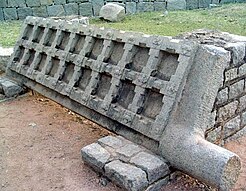
Stone door in Hampi (India)

Ancient doors were hung by pintles at the meridian and bottom of the hanging stile, which worked in sockets in the lintel and sill, the latter in some hard rock such as basalt or granite. Those Hilprecht found at Nippur, dating from 2000 BC, were in dolerite. The tenons of the gates at Balawat were sheathed with bronze (now in the British Museum). These doors or gates were hung in 2 leaves, each about 2.54 m (100 in) broad and viii.ii thousand (27 ft) loftier; they were encased with bronze bands or strips, 25.iv cm (10.0 in) high, covered with repoussé ornament of figures. The forest doors would seem to take been virtually 7.62 cm (three.00 in) thick, only the hanging stile was over 360 millimetres (14 in) bore. Other sheathings of various sizes in bronze evidence this was a universal method adopted to protect the wood pivots. In the Hauran in Syrian arab republic where timber is scarce, the doors were made of stone, and one measuring 1.63 m (5.iii ft) by 0.79 m (31 in) is in the British Museum; the band on the coming together stile shows that it was i of the leaves of a double door. At Kuffeir most Bostra in Syrian arab republic, Burckhardt found rock doors, 2.74 to 3.048 m (8.99 to 10.00 ft) high, being the entrance doors of the town. In Etruria many stone doors are referred to by Dennis.

Roman folding doors at Pompeii, from the first century Advertizing, similar with Neoclassical doors from the 19th century
Ancient Greek and Roman doors were either single doors, double doors, triple doors, sliding doors or folding doors, in the terminal case the leaves were hinged and folded dorsum. In the tomb of Theron at Agrigentum there is a single four-panel door carved in stone. In the Blundell collection is a bas-relief of a temple with double doors, each leaf with five panels. Amid existing examples, the bronze doors in the church building of SS. Cosmas and Damiano, in Rome, are of import examples of Roman metal piece of work of the all-time menstruation; they are in 2 leaves, each with two panels, and are framed in bronze. Those of the Pantheon are similar in design, with narrow horizontal panels in addition, at the top, bottom and middle. Two other bronze doors of the Roman catamenia are in the Lateran Basilica.
The Greek scholar Heron of Alexandria created the earliest known automatic door in the offset century Ad during the era of Roman Egypt.[iii] The first foot-sensor-activated automatic door was fabricated in China during the reign of Emperor Yang of Sui (r. 604–618), who had i installed for his royal library.[3] The offset automatic gate operators were afterwards created in 1206 by Arab inventor Al-Jazari.[4] [ need quotation to verify ]
Copper and its alloys were integral in medieval architecture. The doors of the church of the Nativity at Bethlehem (sixth century) are covered with plates of bronze, cut out in patterns. Those of Hagia Sophia at Constantinople, of the eighth and ninth century, are wrought in statuary, and the west doors of the cathedral of Aix-la-Chapelle (9th century), of similar industry, were probably brought from Constantinople, as also some of those in St. Marks, Venice. The bronze doors on the Aachen Cathedral in Frg appointment back to about 800 AD. Statuary baptistery doors at the Cathedral of Florence were completed in 1423 past Ghiberti.[v] (For more information, encounter: Copper in architecture).

Of the 11th and 12th centuries there are numerous examples of bronze doors, the earliest being one at Hildesheim, Deutschland (1015). The Hildesheim design affected the concept of Gniezno door in Poland. Of others in South Italia and Sicily, the following are the finest: in Sant'Andrea, Amalfi (1060); Salerno (1099); Canosa di Puglia (1111); Troia, two doors (1119 and 1124); Ravello (1179), by Barisano of Trani, who as well made doors for Trani cathedral; and in Monreale and Pisa cathedrals, by Bonano of Pisa. In all these cases the hanging stile had pivots at the top and bottom. The verbal period when the builder moved to the hinge is unknown, only the change apparently brought about another method of strengthening and decorating doors—wrought-fe bands of various designs. As a rule, three bands with ornamental work found the hinges, with rings exterior the hanging stiles that fit on vertical tenons set into the masonry or wooden frame. There is an early on instance of the 12th century in Lincoln. In France, the metalwork of the doors of Notre Dame at Paris is a beautiful example, just many others be throughout French republic and England.
In Italy, celebrated doors include those of the Battistero di San Giovanni (Florence), which are all in bronze—including the door frames. The modeling of the figures, birds and leafage of the due south doorway, by Andrea Pisano (1330), and of the east doorway by Ghiberti (1425–1452), are of great beauty. In the due north door (1402–1424), Ghiberti adopted the aforementioned scheme of design for the paneling and effigy subjects equally Andrea Pisano, but in the due east door, the rectangular panels are all filled, with bas-reliefs that illustrate Scripture subjects and innumerable figures. These may the gates of Paradise of which Michelangelo speaks.
Doors of the mosques in Cairo were of two kinds: those externally cased with sheets of statuary or iron, cutting in decorative patterns, and incised or inlaid, with bosses in relief; and those of woods-framed with interlaced square and diamond designs. The latter pattern is Coptic in origin. The doors of the palace at Palermo, which were fabricated by Saracenic workmen for the Normans, are fine examples in good preservation. A somewhat similar decorative class of door is found in Verona, where the edges of the stiles and rail are beveled and notched.

In the Renaissance period, Italian doors are quite uncomplicated, their architects trusting more than to the doorways for result; but in France and Deutschland the opposite is the case, the doors being elaborately carved, especially in the Louis XIV and Louis XV periods, and sometimes with architectural features such equally columns and entablatures with pediment and niches, the doorway being in apparently masonry. While in Italy the tendency was to give scale by increasing the number of panels, in France the contrary seems to accept been the rule; and ane of the great doors at Fontainebleau, which is in two leaves, is entirely carried out as if consisting of one great panel only.
The primeval Renaissance doors in France are those of the cathedral of St. Sauveur at Aix (1503). In the lower panels there are figures 3 ft (0.91 m). loftier in Gothic niches, and in the upper panels a double range of niches with figures about 2 ft (0.61 m). loftier with canopies over them, all carved in cedar. The south door of Beauvais Cathedral is in some respects the finest in France; the upper panels are carved in loftier relief with figure subjects and canopies over them. The doors of the church at Gisors (1575) are carved with figures in niches subdivided past classic pilasters superimposed. In St. Maclou at Rouen are three magnificently carved doors; those past Jean Goujon have figures in niches on each side, and others in a grouping of bully beauty in the center. The other doors, probably about twoscore to fifty years later, are enriched with bas-reliefs, landscapes, figures and elaborate interlaced borders.
NASA's Vehicle Assembly Building at the Kennedy Space Heart contains the 4 largest doors. The Vehicle Assembly Building was originally congenital for the assembly of the Apollo missions' Saturn vehicles and was then used to support Infinite Shuttle operations. Each of the four doors are 139 meters (456 anxiety) high.[6]
The oldest door in England tin can be found in Westminster Abbey and dates from 1050.[vii] In England in the 17th century the door panels were raised with bolection or projecting moldings, sometimes richly carved, around them; in the 18th century the moldings worked on the stiles and rails were carved with the egg-and-sprint ornamentation.
- Short visual history of doors
-

-
-
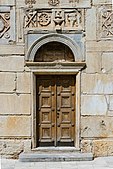
-

-

-

-

-

Rococo door on Rue Monsieur-le-Prince (Paris)
-
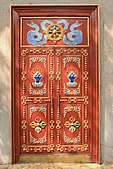
-

-

-
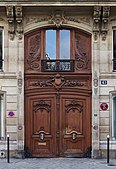
19th century Eclectic Classicist door on Rue La Bruyère (Paris)
-

-
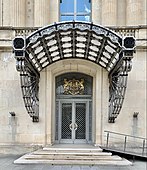
Pattern and styles [edit]
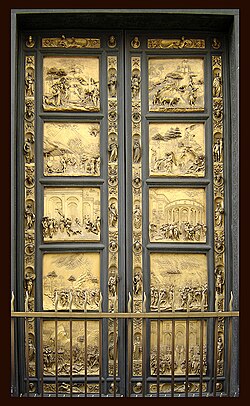
Door of the Florence Baptistery chosen The Gates of Paradise, 1425–1452, gilded bronze, height: 5.2 1000

At that place are many kinds of doors, with dissimilar purposes. The most mutual blazon is the single-leaf door, which consists of a single rigid panel that fills the doorway. In that location are many variations on this basic design, such as the double-leaf door or double door and French windows, which have two side by side contained panels hinged on each side of the doorway.
- A half door or Dutch door [viii] or stable door is divided in half horizontally. Traditionally the top half opens so a worker can feed a equus caballus or other animal while the bottom one-half remains airtight to keep the animal within. This manner of door has been adapted for homes.
- Saloon doors are a pair of lightweight swing doors often found in public bars, and particularly associated with the American west. Saloon doors, likewise known as cafe doors, oft use bidirectional hinges that shut the door regardless of which direction it opens past incorporating springs. Saloon doors that simply extend from genu-level to breast-level are known equally batwing doors.
- A blind door, Gibb door, or jib door has no visible trim or operable components. It blends with the adjacent wall in all finishes, to appear as role of the wall—a bearded door.[9]
- A French door consists of a frame around one or more than transparent or translucent panels (called lights or lites) that may be installed singly, in matching pairs, or even as serial. A matching pair of these doors is called a French window, equally information technology resembles a door-peak casement window. When a pair of French doors is used equally a French window, the application does not by and large include a cardinal mullion (as practice some casement window pairs), thus allowing a wider unobstructed opening. The frame typically requires a weather strip at flooring level and where the doors meet to prevent water ingress. An espagnolette bolt may let the head and foot of each door be secured in one movement. The slender window joinery maximizes light into the room and minimizes the visual affect of the doorway joinery when considered externally. The doors of a French window often open outward onto a balconet, balcony, porch, or terrace and they may provide an entrance to a garden.
- A louvered door has stock-still or movable wooden fins (often chosen slats or louvers) which permit open ventilation while preserving privacy and preventing the passage of light to the interior. Beingness relatively weak structures, they are most commonly used for wardrobes and drying rooms, where security is of less importance than good ventilation, although a very similar structure is ordinarily used to form window shutters. Double louvred doors were introduced into Seagate, congenital in Florida in 1929 by Gwendolyn and Powel Crosley, that provided the desired circulation of air with an added degree of privacy in that it is impossible to see through the fins in any management.
- A composite door is a single leafage door that can exist solid or with drinking glass, and is usually filled with loftier density foam. In the U.k., composite doors are ordinarily certified to BS PAS 23/24[x] and exist compliant with Secured past Pattern, an official United kingdom police initiative.[11]
- A steel security door is one which is made from strong steel, ofttimes for apply on vaults and safe rooms to withstand set on. These may likewise exist fitted with wooden outer panels to resemble standard internal and external doors.[12]
- A flush door is a completely smooth door, having plywood or MDF fixed over a light timber frame, the hollow parts of which are often filled with a paper-thin core material. Skins can likewise exist made out of hardboards, the start of which was invented by William H Mason in 1924. Chosen Masonite, its construction involved pressing and steaming wood chips into boards. Flush doors are almost commonly employed in the interior of a dwelling, although slightly more than substantial versions are occasionally used as exterior doors, particularly inside hotels and other buildings containing many independent dwellings.
- A moulded door has the same structure as that of flush door. The only divergence is that the surface fabric is a moulded skin made of MDF. Skins can likewise be made out of hardboards.
- A ledge and brace door often chosen board and batten doors are made from multiple vertical boards fixed together by 2 or more horizontal timbers called ledges (or battens)and sometimes kept square by additional diagonal timbers chosen braces.
- A wicket door is a pedestrian door built into a much larger door allowing access without requiring the opening of the larger door. Examples might be found on the ceremonial door of a cathedral or in a big vehicle door in a garage or hangar.
- A bifold door is a unit that has several sections, folding in pairs. Wood is the most common material, and doors may also be metal or glass. Bifolds are most commonly made for closets, but may too exist used as units between rooms. Bi-fold doors are essentially now doors that let the outside in. They open up in concert; where the panels fold up against one another and are pushed together when opened. The master door panel (often known as the traffic door) is accompanied by a stack of panels that fold very neatly confronting one another when opened fully, which almost await like room dividers.[13]
- A sliding drinking glass door, sometimes called an Arcadia door or patio door, is a door made of glass that slides open and sometimes has a screen (a removable metal mesh that covers the door).
- Australian doors are a pair of plywood swinging doors oft plant in Australian public houses. These doors are mostly ruby or brown in color and deport a resemblance to the more formal doors found in other British Colonies' public houses.
- A false door is a wall decoration that looks like a window. In ancient Egyptian architecture, this was a common element in a tomb, the simulated door representing a gate to the afterlife. They can likewise exist found in the funerary architecture of the desert tribes (eastward.g., Libyan Ghirza).
- A doormat (also chosen door mat) is a mat placed typically in forepart of or behind a door of a home. This practise originated so that mud and dirt would be less prevalent on floors inside a building.
Types [edit]

The main types of door mechanisms
Hinged [edit]
Most doors are hinged along one side to permit the door to pivot away from the doorway in i direction, merely not the other. The axis of rotation is usually vertical. In some cases, such as hinged garage doors, the centrality may be horizontal, above the door opening.
Doors tin be hinged so that the centrality of rotation is not in the aeroplane of the door to reduce the infinite required on the side to which the door opens. This requires a mechanism so that the axis of rotation is on the side other than that in which the door opens. This is sometimes the case in trains or airplanes, such as for the door to the toilet, which opens inward.
A swing door has special unmarried-activeness hinges that allow it to open either outward or inward, and is ordinarily sprung to keep information technology airtight.
French doors are derived from an original French design called the casement door. It is a door with lites where all or some panels would exist in a casement door. A French door traditionally has a moulded console at the bottom of the door. It is called a French window when used in a pair as double-leaved doors with large drinking glass panels in each door leaf, and in which the doors may swing out (typically) every bit well every bit in.
A Mead door, developed past S. Mead of Leicester, swings both ways. It is susceptible to forced entry due to its pattern.
A Dutch door or stable door consists of ii halves. The top half operates independently from the lesser half. A variant exists in which opening the summit part separately is possible, but because the lower function has a lip on the inside, closing the top office, while leaving the lower part open up, is not.
A garden door resembles a French window (with lites), but is more secure considering only one door is operable. The swivel of the operating door is next to the adjacent fixed door and the latch is located at the wall opening jamb rather than between the 2 doors or with the use of an espagnolette bolt.
Sliding [edit]
It is often useful to have doors which slide along tracks, frequently for space or aesthetic considerations.
A bypass door is a door unit of measurement that has two or more sections. The doors tin can slide in either direction forth 1 axis on parallel overhead tracks, sliding past each other. They are well-nigh commonly used in closets to provide access ane side of the cupboard at a time. Doors in a bypass unit of measurement overlap slightly when viewed from the front so they don't have a visible gap when closed.
Doors which slide inside a wall cavity are called pocket doors. This type of door is used in tight spaces where privacy is also required. The door slab is mounted to roller and a track at the top of the door and slides inside a wall.
Sliding glass doors are common in many houses, particularly every bit an archway to the lawn. Such doors are also pop for utilize for the entrances to commercial structures, although they are not counted as burn leave doors. The door that moves is called the "active foliage", while the door that remains fixed is called the "inactive leafage".
Rotating [edit]
A revolving door has several wings or leaves, by and large four, radiating from a key shaft, forming compartments that rotate about a vertical axis. A revolving door allows people to pass in both directions without colliding, and forms an airlock maintaining a seal between inside and out.
A pivot door, instead of hinges, is supported on a bearing some distance away from the edge, so that there is more than or less of a gap on the pivot side too as the opening side. In some cases the pivot is primal, creating two equal openings.
Loftier-speed [edit]
A high-speed door is a very fast door some with opening speeds of up to 4 m/s, mainly used in the industrial sector where the speed of a door has an effect on product logistics, temperature and pressure level control. loftier-speed clean room doors are used in pharmaceutical industries for the special curtain and stainless steel frames. They guarantee the tightness of all accesses. The powerful high-speed doors have a smooth surface structure and no protruding edges. Therefore, they tin can be easily cleaned and depositing of particles is largely excluded.
Loftier-speed doors are fabricated to handle a high number of openings, generally more than 200,000 a yr. They must be congenital with heavy duty parts and counterbalance systems for speed enhancement and emergency opening role. The door curtain was originally fabricated of PVC, but was later on likewise developed in aluminium and acrylic glass sections. High Speed refrigeration and cold room doors with first-class insulation values was also introduced with the Green and Energy saving requirements.
In N America, the Door and Access Systems Manufacturing Association (DASMA) defines loftier-functioning doors as non-residential, powered doors, characterized by rolling, folding, sliding or swinging action, that are either high-cycle (minimum 100 cycles/mean solar day) or high-speed (minimum 20 inches (508 mm)/second), and two out of three of the following: made-to-society for exact size and custom features, able to withstand equipment bear upon (break-away if accidentally hit by vehicle), or able to sustain heavy utilise with minimal maintenance.
Automated [edit]
Automatically opening doors are powered open and closed either by electricity, bound, or both. There are several methods by which an automatically opening door is activated:
- A sensor detects traffic is budgeted. Sensors for automatic doors are generally:
- A pressure sensor – eastward.g., a floor mat which reacts to the force per unit area of someone standing on information technology.
- An infrared curtain or beam which shines invisible light onto sensors; if someone or something blocks the beam the door is triggered open.
- A motion sensor which uses low-power microwave radar for the same effect.
- A remote sensor (eastward.thou. based on infrared or radio waves) tin can exist triggered past a portable remote control, or is installed inside a vehicle. These are popular for garage doors.
- A switch is operated manually, mayhap after security checks. This can be a push button switch or a swipe card.
- The act of pushing or pulling the door triggers the open and close bicycle. These are as well known equally power-assisted doors.
In addition to activation sensors, automatically opening doors are generally fitted with rubber sensors. These are usually an infrared curtain or beam, but can be a pressure level mat fitted on the swing side of the door. The prophylactic sensor prevents the door from colliding with an object by stopping or slowing its motion. A machinery in modern automated doors ensures that the door can open in a power failure.
Other [edit]

Sectional doors for industry
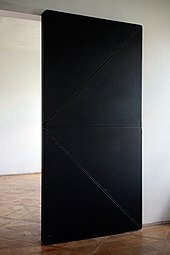
Up-and-over or overhead doors are oft used in garages. Instead of hinges, information technology has a mechanism, oft counterbalanced or sprung, so it can elevator and rest horizontally above the opening. A roller shutter or exclusive overhead door is one variant of this type.
A tambour door or roller door is an up-and-over door made of narrow horizontal slats and "rolls" up and down by sliding along vertical tracks and is typically found in entertainment centres and cabinets.
Rebated doors, a term chiefly used in Britain, are double doors having a lip or overlap (i.e. a Rabbet) on the vertical edge(s) where they encounter. Burn down-rating tin be accomplished with an practical edge-guard or astragal molding on the meeting stile, in accord with the American fire door.
Evolution Door is a trackless door that moves in the same closure level every bit a sliding door. The arrangement is an invention of the Austrian creative person Klemens Torggler. Information technology is a further evolution of the Drehplattentür [de] that unremarkably consists of 2 rotatable, connected panels which move to each other when opening.[14]
Applications [edit]
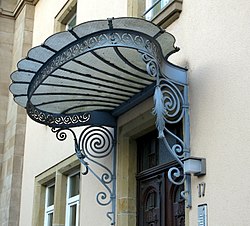
Architectural doors have numerous general and specialized uses. Doors are generally used to separate interior spaces (closets, rooms, etc.) for convenience, privacy, safe, and security reasons. Doors are also used to secure passages into a edifice from the exterior, for reasons of climate control and safety.
Doors as well are practical in more specialized cases:
- A blast-proof door is constructed to allow access to a structure as well as to provide protection from the force of explosions.
- A garden door is any door that opens to a backyard or garden. This term is often used specifically for French windows, double French doors (with lites instead of panels), in place of a sliding glass door. The term also may refer to what is known as patio doors.[ citation needed ]
- A jib door is a concealed door, whose surface reflects the moldings and finishes of the wall. These were used in historic English houses, mainly as servants' doors.[15] : 101
- A pet door (likewise known as a cat flap or dog door) is an opening in a door to allow pets to enter and exit without the main door'south beingness opened. Information technology may exist but covered by a rubber flap, or information technology may be an actual door hinged on the pinnacle that the pet tin push through. Pet doors may be mounted in a sliding glass door as a new (permanent or temporary) console. Pet doors may be unidirectional, just allowing pets to get out. Additionally, pet doors may exist electronic, but assuasive animals with a special electronic tag to enter.
- A trapdoor is a door that is oriented horizontally in a ceiling or floor, often accessed via a ladder.
- A water door or h2o archway, such as those used in Venice, Italy, is a door leading from a building built on the h2o, such as a culvert, to the h2o itself where, for example, one may enter or leave a private gunkhole or h2o taxi.[16] [17]
Construction and components [edit]

Parts of a panel or glazed door

Joint betwixt midrail, lockrail and a gunstock stile

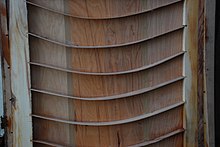
A hollow door with one face removed
Paneling [edit]
Panel doors, besides chosen stile and rail doors, are congenital with frame and panel construction. EN 12519 is describing the terms which are officially used in European Fellow member States. The main parts are listed beneath:
- Stiles – Vertical boards that run the full height of a door and compose its right and left edges. The hinges are mounted to the fixed side (known equally the "hanging stile"), and the handle, lock, bolt or latch are mounted on the swinging side (known equally the "latch stile").
- Rail – Horizontal boards at the top, bottom, and optionally in the middle of a door that join the two stiles and split the door into two or more than rows of panels. The "pinnacle track" and "bottom rail" are named for their positions. The lesser rail is too known as "boot rail". A eye track at the pinnacle of the bolt is known as the "lock rail", other middle rails are commonly known as "cross rails".
- Mullions – Smaller optional vertical boards that run between 2 track, and split the door into 2 or more than columns of panels, the term is used sometimes for verticals in doors, but more often (UK and Commonwealth of australia) it refers to verticals in windows.
- Muntin – Optional vertical members that divide the door into smaller panels.
- Panels – Big, wider boards used to fill the space betwixt the stiles, rail, and mullions. The panels typically fit into grooves in the other pieces, and help to keep the door rigid. Panels may be flat, or in raised console designs. Can be glued in or stay every bit a floating console.
- Light – a piece of glass used in place of a panel, essentially giving the door a window.
Board battening [edit]
Also known as ledges and braced, board and batten doors are an older design consisting primarily of vertical slats:
- Planks – Boards wider than 9" that extend the full height of the door, and are placed side by side filling the door'south width.
- Ledges and braces – Ledges extend horizontally across the door which the boards are affixed to. The ledges hold the planks together. When diagonally they are called braces which preclude the door from skewing. On some doors, especially antiquarian ones, the ledges are replaced with atomic number 26 bars that are often built into the hinges as extensions of the door-side plates.
Ledging and bracing [edit]
As board and Batten doors.
Impact resistance [edit]
Impact-resistant doors take rounded stile edges to dissipate energy and minimize edge chipping, scratching and denting. The formed edges are frequently made of an engineered material. Impact-resistant doors excel in high traffic areas such as hospitals, schools, hotels and coastal areas.
Frame and fill [edit]
This type consists of a solid timber frame, filled on one face, face with tongue and groove boards. Quite often used externally with the boards on the weather face.
Flushing [edit]
Many modern doors, including most interior doors, are flush doors:
- Stiles and rails – As above, but usually smaller. They class the exterior edges of the door.
- Core material – Material inside the door used simply to fill infinite, provide rigidity and reduce drumminess.
- Hollow-core – Oft consists of a lattice or honeycomb fabricated of corrugated cardboard, or thin wooden slats. Can also be built with staggered wooden blocks. Hollow-cadre flush doors are usually used equally interior doors.
- Lock block – A solid block of wood mounted inside a hollow-core affluent door virtually the bolt to provide a solid and stable location for mounting the door's hardware.
- Stave-core – Consists of wooden slats stacked upon one some other in a manner similar to a board and batten door (though the slats are normally thinner) or the wooden-block hollow-core (except that the space is entirely filled).
- Solid-core – Can consist of low-density particle board or foam used to completely make full the space within the door. Solid-cadre affluent doors (specially foam-core ones) are commonly used as exterior doors considering they provide more insulation and strength.
- Hollow-core – Oft consists of a lattice or honeycomb fabricated of corrugated cardboard, or thin wooden slats. Can also be built with staggered wooden blocks. Hollow-cadre flush doors are usually used equally interior doors.
- Pare – The front end and back faces of the door are then covered with wood veneer, thin plywood, sheet metal, fiberglass, or vinyl. The wooden materials are commonly layered with the grain alternating management between layers to preclude warping. Fiberglass and metal-faced doors are sometimes given a layer of cellulose and so that they may be stained to look like wood.
Moulding [edit]
- Stiles and rails – Equally above, but usually smaller. They grade the outside edges of the door.
- Core material: Cloth within the door used but to fill space, provide rigidity and reduce druminess.
- Hollow-core – Oftentimes consists of a lattice or honeycomb made of corrugated cardboard, extruded polystyrene foam, or thin wooden slats. Can as well be built with staggered wooden blocks. Hollow-core molded doors are normally used as interior doors.[18]
- Lock cake – A solid block of forest mounted within a hollow-cadre flush door most the bolt to provide a solid and stable location for mounting the door's hardware.
- Stave-core – Consists of wooden slats stacked upon one some other in a fashion similar to a board & batten door (though the slats are ordinarily thinner) or the wooden-block hollow-core (except that the space is entirely filled).
- Solid-cadre – Tin can consist of low-density particle board or cream used to completely fill the infinite within the door. Solid-cadre flush doors (especially foam-cadre ones) are normally used as exterior doors because they provide more insulation and strength.
- Hollow-core – Oftentimes consists of a lattice or honeycomb made of corrugated cardboard, extruded polystyrene foam, or thin wooden slats. Can as well be built with staggered wooden blocks. Hollow-core molded doors are normally used as interior doors.[18]
- Pare – The front and back faces of the door are covered with HDF/MDF skins.
Swing direction [edit]
For most of the world,[ citation needed ] door swings, or handing, are determined while standing on the outside or less secure side of the door while facing the door (i.eastward., standing on the side requiring a key to open, going from outside to inside, or from public to private).
Information technology is important to become the hand and swing correct on exterior doors, as the transom is usually sloped and sealed to resist water entry, and properly drain. In some custom millwork (or with some master carpenters), the manufacture or installer bevels the leading edge (the first border to meet the jamb as the door closes) and so that the door fits tight without binding. Specifying an incorrect hand or swing can make the door bind, not close properly, or leak. Fixing this fault is expensive or fourth dimension-consuming. In North America, many doors now come with factory-installed hinges, pre-hung on the jamb and sills.
While facing the door from the exterior or less secure side, if the swivel is on the correct side of the door, the door is "correct handed"; or if the hinge is on the left, it is "left handed". If the door swings toward yous, it is "reverse swing"; or if the door swings abroad from you lot, it is "normal swing".
In other words:
- In the United States:
- Left manus hinge (LHH): Standing outside (or on the less secure side, or on the public side of the door), the hinges are on the left and the door opens in (away from you).
- Correct manus swivel (RHH): Continuing outside (or on the less secure side), the hinges are on the right and the door opens in (abroad from yous).
- Left hand reverse (LHR): Standing outside the house (or on the less secure side), the hinges are on the left, knob on right, on opening the door it swings toward you (i.e. the door swings open toward the outside, or "outswing")
- Correct hand contrary (RHR): Standing outside the house (i.eastward. on the less secure side), the hinges are on the right, knob on left, opening the door past pulling the door toward yous (i.eastward. open swings to the exterior, or "outswing")
- In Europe:
- One of the oldest DIN standard applies: DIN 107 "Building construction; identification of right and left side" (first 1922–05, electric current 1974–04) defines that doors are categorized from the side where the door hinges can exist seen. If the hinges are on the left, it is a DIN Left door (DIN links, DIN gauche), if the hinges are on the right, it is a DIN Right door (DIN rechts, DIN droite). The DIN Right and DIN Left marking are also used to categorize matching installation material such equally mortise locks (referenced in DIN 107). The European Standard DIN EN 12519 "Windows and pedestrian doors. Terminology" includes these definitions of orientation.
- In Commonwealth of australia:
- The "refrigerator rule" applies, and a refrigerator door is non opened from the within. If the hinges are on the right then it is a right hand (or right hung) door. (Australian Standards for Installation of Timber Doorsets, Equally 1909–1984 pg 6.)
- In public buildings, exterior doors open to the outside to comply with applicable fire codes. In a fire, a door that opens inward could crusade a crush of people who tin't open it.[19]
Main materials [edit]
New exterior doors are largely defined by the type of materials they are made from: wood, steel, fiberglass, UPVC/vinyl, aluminum, composite, glass (patio doors), etc.
Wooden doors – including solid woods doors – are a acme choice for many homeowners, largely because of the aesthetic qualities of forest. Many wood doors are custom-made, but they take several downsides: their price, their maintenance requirements (regular painting and staining) and their limited insulating value[20] (R-5 to R-half-dozen, not including the effects of the glass elements of the doors). Forest doors often take an overhang requirement to maintain a warranty. An overhang is a roof, porch area or awning that helps to protect the door and its finish from UV rays.
Steel doors are another major blazon of residential front doors; most of them come with a polyurethane or other type of cream insulation cadre – a disquisitional factor in a building'south overall condolement and efficiency. Steel doors mostly in default comes along with frame and lock system, which is a high cost efficiency factor compared to wooden doors.
Most modern outside walls provide thermal insulation and energy efficiency, which can be indicated by the Energy Star label or the Passive House standards. Premium composite (including steel doors with a thick core of polyurethane or other foam), fiberglass and vinyl doors benefit from the materials they are made from, from a thermal perspective.
Insulation and weatherstripping [edit]
Just in that location are very few door models with an R-value close to 10 (the R-value measures how well a barrier resists the conductive menstruation of rut). This is far less than the R-xl walls or the R-50 ceilings of super-insulated buildings – Passive Solar and Zero Free energy Buildings. Typical doors are not thick plenty to provide very high levels of free energy efficiency.
Many doors may have good R-values at their eye, only their overall energy efficiency is reduced because of the presence of glass and reinforcing elements, or because of poor weatherstripping and the way the door is manufactured.
Door weatherstripping is particularly of import for free energy efficiency. German language-made passive firm doors use multiple weatherstrips, including magnetic strips, to meet higher standards. These weatherstrips reduce energy losses due to air leakage.
Dimensions [edit]
U.s.a. [edit]
Standard door sizes in the U.s.a. run along ii" increments. Customary sizes have a height of 78" (1981 mm) or 80" (2032 mm) and a width of eighteen" (472 mm), 24" (610 mm), 26" (660 mm), 28" (711 mm), xxx" (762 mm) or 36" (914 mm).[21] Most residential passage (room to room) doors are 30" x fourscore" (762 mm × 2032 mm).
A standard US residential (exterior) door size is 36" × 80" (91 × 203 cm). Interior doors for wheelchair access must also take a minimum width of 3' 0" (91 cm). Residential interior doors are often somewhat smaller being half dozen' 8" loftier, every bit are many small stores, offices, and other light commercial buildings. Larger commercial, public buildings and k homes often use doors of greater pinnacle. Older buildings oftentimes have smaller doors.
Thickness: Most pre-made doors are one 3/8" thick (for interior doors) or 1 three/iv" (exterior).
Closets: pocket-size spaces such as closets, dressing rooms, half-baths, storage rooms, cellars, etc. often are accessed through doors smaller than passage doors in 1 or both dimensions simply like in design.
Garages: Garage doors are generally seven' 0" or 8' 0" wide for a single-automobile opening. 2 auto garage doors (sometimes called double automobile doors) are a unmarried door 16' 0". Because of size and weight these doors are unremarkably sectional. That is carve up into four or five horizontal sections so that they tin be raised more easily and don't crave a lot of additional space in a higher place the door when opening and closing. Single piece double garage doors are common in some older homes.
Europe [edit]
Standard DIN doors are defined in DIN 18101 (published 1955–07, 1985–01, 2014–08). Door sizes are too given in the construction standard for wooden door panels (DIN 68706–1). The DIN committee created the harmonized European standard DIN EN 14351-1 for exterior doors and DIN EN 14351-ii for interior doors (published 2006–07, 2010–08), which define requirements for the CE marking and provide standard sizes by examples in the appendix.
The DIN 18101 standard has a normative size (Nennmaß) slightly larger than the panel size (Türblatt) as the standard derives the panel sizes from the normative size being unlike single door vs double door and molded vs unmolded doors. DIN 18101/1985 defines interior unmarried molded doors to have a mutual panel top of 1985 mm (normativ tiptop 2010 mm) at panel widths of 610 mm, 735 mm, 860 mm, 985 mm, 1110 mm, plus a larger door panel size of 1110 mm 10 2110 mm.[22] The newer DIN 18101/2014 drops the definition of simply five standard door sizes in favor of a basic raster running along 125 mm increments where the height and width are contained. Panel width may be in the range 485 mm to 1360 mmm, and the height may be in the range of 1610 mm to 2735 mm.[23] The most common interior door is 860 mm x 1985 mm (33.viii" 10 78.1").
Doorways [edit]

A diagram illustrating the components of a panel door
When framed in woods for snug plumbing equipment of a door, the doorway consists of two vertical jambs on either side, a lintel or head jamb at the top, and perhaps a threshold at the bottom. When a door has more than one movable section, one of the sections may be called a leafage. See door furniture for a discussion of attachments to doors such as door handles, doorknobs, and door knockers.
- Lintel – A horizontal beam above a door that supports the wall above it. (Besides known every bit a header)
- Jambs or legs – The vertical posts that class the sides of a door frame, where the hinges are mounted, and with which the bolt interacts.
- Sill (for exterior doors) – A horizontal sill plate beneath the door that supports the door frame. Similar to a Window Sill merely for a door
- Threshold (for exterior doors) – A horizontal plate below the door that bridges the crevice between the interior flooring and the sill.
- Doorstop – a thin slat congenital inside the frame to prevent a door from swinging through when airtight, an act which might break the hinges.
- Architrave – The decorative molding that outlines a door frame. (called an Archivolt if the door is arched). Chosen door casing or brickmold in North America.
-
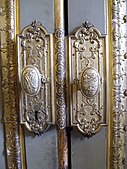
Pair of door knobs in the Galerie dorée de la Banque de France of the Hôtel de Toulouse (Paris)
[edit]
Door article of furniture or hardware refers to whatsoever of the items that are attached to a door or a drawer to enhance its functionality or appearance. This includes items such as hinges, handles, door stops, etc.
Rubber [edit]
Door safety relates to prevention of door-related accidents. Such accidents take place in various forms, and in a number of locations; ranging from car doors to garage doors. Accidents vary in severity and frequency. According to the National Safety Council in the United States, around 300,000 door-related injuries occur every year.[24]
The types of accidents vary from relatively pocket-sized cases where doors crusade damage to other objects, such equally walls, to serious cases resulting in human injury, particularly to fingers, hands, and anxiety. A closing door tin can exert upward to 40 tons per square inch of force per unit area between the hinges. Considering of the number of accidents taking identify, there has been a surge in the number of lawsuits. Thus organisations may be at run a risk when car doors or doors inside buildings are unprotected.
According to the U.s.a. General Services Administration, discussing child care centres:
...Information technology is essential that children'south fingers be protected from being crushed or otherwise injured in the hinge space of a swinging door or gate. There are elementary devices available to adhere to the hinge side, ensuring that this type of injury does not occur. As the door closes, the mitt is pushed out of the opening, abroad from harm. In improver, immature children are vulnerable to injury when they fall against the other (hinged) side of doors and gates, striking projected hinges. Piano hinges are not recommended to alleviate this problem as they tend to sag over fourth dimension with heavy utilize. Instead, an inexpensive device fitting over hinges is available on the market and should exist used to ensure rubber...[25]
Opening management [edit]
Whenever a door is opened outward, there is a risk that it could strike some other person. In many cases this can be avoided by architectural design which favors doors which open up inward to rooms (from the perspective of a common area such as a corridor, the door opens outward). In cases where this is infeasible, it may exist possible to avoid an accident by placing vision panels in the door.[26]
Inward-hinged doors can likewise escalate an accident by preventing people from escaping the building: people inside the edifice may press against the doors, and thus forestall the doors from opening. Related accidents include:
- Grue Church fire - Grue, Norway in 1822
- Victoria Hall Disaster - Sunderland, UK in 1883
- Glen Movie theater disaster - Paisley, Britain in 1929
- Cocoanut Grove fire - Boston, The states in 1942
Today, the exterior doors of most big (especially public) buildings open up outward, while interior doors such every bit doors to private rooms, offices, suites, etc. open in, as do many exterior doors of houses, particularly in Due north America.
Stops [edit]
Doorstops are unproblematic devices that prevent a door from contacting and possibly dissentious another object (typically a wall). They may either blot the strength of a moving door, or hold the door confronting unintended motion.
Guards [edit]
Door guards (hinge guards, anti-finger trapping devices, or finger guards) assist prevent finger trapping accidents, equally doors pose a take chances to children, peculiarly when closing. Door guards protect fingers in door hinges by covering the swivel-side gap of an open door, typically with a slice of rubber or plastic that wraps from the door frame to the door. Other door safety products eject the fingers from the push side of the door every bit it closes.
At that place are various levels of door protection. Anti-finger trapping devices in front may exit the rear hinge pin side of doors unprotected. Total door protection uses front end and rear anti-finger trapping devices and ensures the hinge side of a door is fully isolated. A risk assessment of the door determines the appropriate level of protection.
There is as well handle-side door protection, which prevents the door from slamming shut on the frame, which tin can crusade injury to fingers/hands.
Glass [edit]
Glass doors pose the risk of unintentional collision if a person is unaware there is a door, or thinks it is open when information technology is not. This risk is greater with sliding drinking glass doors considering they ofttimes have large single panes that are hard to see. Stickers or other types of warnings on the glass surface make information technology more visible and help prevent injury. In the UK, Regulation fourteen of the Workplace (Health and Rubber Regulations) 1992 requires that builders mark windows and glass doors to brand them conspicuous. Australian Standards: AS1288 and AS2208 require that glass doors exist made of laminated, tempered, or toughened drinking glass.
Fire [edit]
Buildings often have special purpose doors that automatically close to prevent the spread of burn down and fume. Fire doors that are improperly installed or tampered with can increment risk during a burn. Sometimes, door closer mechanisms ensure burn down doors remain closed.
An additional burn down risk is that doors may preclude access to emergency services personnel coming to fight the fire and rescue occupants, etc. Fire fighters must employ door breaching techniques in these situations to gain admission.
Doors in public buildings ofttimes have panic confined, which open up the door in response to anyone pressing against the bar from the within in the event of a fire or other emergency.
Automobiles [edit]
Vehicle doors nowadays an increased risk of trapping hands or fingers due to the proximity of occupants. In some auto accidents, injury to occupants from the motility of car doors occurs.[ citation needed ]
Bicyclists cycling on public roads risk dooring: standoff with an abruptly opened vehicle door. Considering cyclists oftentimes ride near parked cars alongside the route, they are particularly vulnerable.
Aircraft [edit]
In shipping, doors from pressurized sections to un-pressurized compartments or the exterior can pose risk if they open up during flight. Air may rush out of the fuselage with sufficient velocity to squirt unsecured occupants, cargo, and other items, and drastic pressure differences between compartments may make shipping floors or other interior partitions fail. These concerns are typically mitigated with plug doors, which open up in toward the pressurized compartment and are forced into their door frames by the difference in air pressure level. Virtually cabin doors are of this blazon, just cargo doors typically open outward to maximise interior space, and require hefty locking mechanisms to overcome internal pressure and prevent explosive decompression.
A number of aircraft accidents involved outward-opening door failures, including:
- American Airlines Flying 96 (1972)
- Turkish Airlines Flight 981 (1974)
- 1975 Tân Sơn Nhứt C-5 blow
- United Airlines Flight 811 (1989)
See besides [edit]
- Biometrics
- Closed-circuit television
- Coal hole
- Door loop, a method for providing electric cabling to a door
- Door security
- Double margin doors
- Electronic lock
- Hinge bender, a tool for adjusting door hinges
- Identity document
- IP photographic camera
- Janus, Roman god of doors
- Keycards
- Locksmithing
- Lock picking
- Logical security
Citations [edit]
- ^ Encounter, for example the doorkeeping duties of the Admirer Usher of the Blackness Rod.
- ^ Jordans, Frank (October 20, 2010). "Swiss archaeologists find 5,000-twelvemonth-old door". Archived from the original on Nov viii, 2010 – via The Boston Globe.
- ^ a b Needham, Joseph. (1986). Scientific discipline and Civilization in China: Volume four, Part two, Mechanical Engineering. Taipei: Caves Books, Ltd.
- ^ Howard R. Turner (1997), Science in Medieval Islam: An Illustrated Introduction, p. 181, University of Texas Press, ISBN 0-292-78149-0.
- ^ Architecture, European Copper Plant; "Archived copy". Archived from the original on 2012-ten-09. Retrieved 2012-09-12 .
{{cite web}}: CS1 maint: archived copy every bit title (link) - ^ "Vehicle Assembly Edifice Fact Canvass" (PDF). NASA. NASA. Archived (PDF) from the original on 2016-ten-11. Retrieved 2016-06-03 .
- ^ "Abbey oak door 'Britain'due south oldest'". BBC News. 2005-08-03. Archived from the original on 2006-06-20. Retrieved 2010-05-01 .
- ^ "Door Design Ideas". 25 November 2014. Archived from the original on 2018-01-03. Retrieved 2015-02-24 . Door blueprint ideas
- ^ Nicholson, Peter (1841). The New and Improved Practical Builder. London: Thomas Kelly. pp. 97–98.
- ^ "What does 'certificated' to PAS 24 actually hateful?". thecrimepreventionwebsite.com. Archived from the original on 2014-01-25.
- ^ "Doors and Locks". Secured by Design. Police Criminal offense Prevention Initiative. Retrieved 29 October 2019.
- ^ "Henleys Security Doors". Henleys Security Doors. Archived from the original on 30 May 2016. Retrieved 25 May 2016.
- ^ "Forepart Doors, Garage Doors Insights from The Door Zone". The Door Zone. Archived from the original on 2017-05-07. Retrieved 2017-05-11 .
- ^ Kinematics with MicroStation Ch01C-I Grueblers Criteria for 3D 5 Bar. YouTube. twenty February 2014. Archived from the original on ix April 2016.
- ^ Azzarito, Amy (17 March 2020). The Elements of a Home: Curious Histories behind Everyday Household Objects, from Pillows to Forks. Relate Books. ISBN978-1-4521-7902-v.
- ^ "Doors in Venice: amid water, art and architecture". See Venice, Italy. 20 March 2016. Archived from the original on 2018-01-03.
- ^ Water doors brand frequent appearances in Donna Leon'due south books, and in some are important plot devices, as in Acqua Alta aka Death in High Water (1996) and Abominable Things (2012).
- ^ "Upgrade Your Dwelling house With Gimmicky Affluent Doors - Melissa Goodman". Archived from the original on 2020-09-xx.
- ^ "Why do the entry doors to nigh homes open up inward, while in most public buildings, the entry doors open outward?". 2001-03-02. Archived from the original on 2017-09-20. Retrieved 2017-09-nineteen .
- ^ Outside Doors; Energy.gov; "Doors". Archived from the original on 2015-03-04. Retrieved 2015-03-05 .
- ^ options at homedepot.com
- ^ "Türblattgrößen nach DIN 18101". Archived from the original on 2015-02-19.
- ^ "DIN 18101 Maßnorm für Türen grundlegend überarbeitet". Archived from the original on 2015-01-22.
- ^ "Protecting Children's Fingers from Door Injuries" (PDF). The Redwoods Group. Archived (PDF) from the original on 2012-03-24.
- ^ The states General Services Administration Child Intendance Center Design Guide, June 1998
- ^ Home Safe Guidelines for Architects & Builders, NBS GCR 78-156, BOSTI, December 1978
General references [edit]
- This commodity incorporates text from a publication now in the public domain:Spiers, Richard Phené (1911). "Door". In Chisholm, Hugh (ed.). Encyclopædia Britannica. Vol. 8 (11th ed.). Cambridge University Press. pp. 419–420.
External links [edit]
-
 Media related to Doors at Wikimedia Commons
Media related to Doors at Wikimedia Commons
Source: https://en.wikipedia.org/wiki/Door

0 Response to "How to Get Foot in Door of Concept Art"
Post a Comment